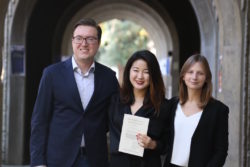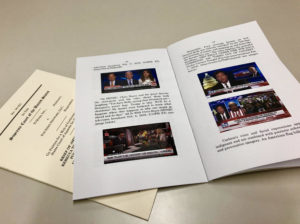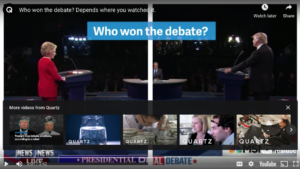Juelsgaard Clinic Urges Supreme Court to Protect Fair Use for Media Criticism, Commentary, and Analysis
Should America’s most-watched cable news network be able to stop a major media-monitoring service provider from recording, indexing, and screening its news coverage—even as the network only publishes 16% of its coverage online and contractually prohibits its licensees from criticizing it? The Juelsgaard Intellectual Property and Innovation Clinic filed an amicus brief last week to address this very concern.
The Clinic urged the Supreme Court to review the lower court’s decision in TVEyes, Inc. v. Fox News Network, LLC. The amicus brief asked the Court to hear the case to ensure that an overly narrow interpretation of fair use under copyright law is not used to hamper robust analysis, criticism, and commentary of broadcast news.

Clinic students Reid Whitaker (’20), Caroline Jo (’20), and Julia Greenberg (’19) represented a diverse group of media critics—Eric Alterman, Brave New Films, Fairness and Accuracy in Reporting—and fair use scholars and advocacy organizations—Professor Rebecca Tushnet, the Electronic Frontier Foundation, the Internet Archive, the Organization for Transformative Works, and the Wikimedia Foundation.
With a grueling 24-hour news cycle and numerous competing outlets, television news has become increasingly fast-paced, skewed, polarized and, at times, unverified. Don’t believe us? Check out the following video highlighting cable news networks’ contrasting coverage of one of the 2016 presidential debates:
And yet, television is the primary source of news for 57% of Americans—and is a preferred source for Americans who are less likely to turn to other news sources.
These developments are concerning—and if the Second Circuit’s decision in TVEyes stands, things will only get worse. Under the Second Circuit’s holding, no one can create the kind of comprehensive, searchable, and reviewable audio-visual television news database, which enables media critics and public commentators to keep the media accountable and the public informed.
Fair use allows for the use of copyrighted materials without permission to facilitate research, reporting, critique, and commentary. The Supreme Court previously held in Campbell v. Acuff-Rose Music, Inc. (1994), that using copyrighted material in a commercial setting without a license does not preclude a finding of fair use.
Yet, the Second Circuit improperly found that TVEyes’ service was not protected by fair use, in part, because it was a commercial service so Fox News deserved the licensing revenue. But the Supreme Court, in Campbell, acknowledged the commonsense fact that copyright holders are extremely unlikely to license content for the purpose of criticizing the copyright owner. And indeed, Fox only licenses its clips on the condition that the licensee “will not show the clips in a way that is derogatory or critical of Fox News.”
If the Second Circuit’s decision is not reviewed, content owners can stifle criticism by withholding licenses from media-monitoring services such as TVEyes. Media critics and public commentators need services like TVEyes. The Clinic’s brief emphasized how researchers can compare simultaneous broadcasts, review political advertising, and analyze editorial decisions, like which topics programs choose not to cover, from thousands of programs aired on hundreds of stations 24 hours per day, seven days per week. Creating and maintaining a similar, comprehensive video database would be prohibitively expensive for individuals, nonprofits, and public institutions.

The Clinic’s brief also used color photos of different broadcasters’ coverage of the same issue to emphasize that original video and audio are crucial for effective commentary. The brief showed how on-screen text, graphics, background images, and accompanying video can influence viewers in powerful ways. As a result, commentators must have access to the original video and audio for their analyses.
Media criticism reveals bias, inaccuracies, and conflicts of interest, and it promotes democratic engagement and accountability by making voters better informed. Criticism is especially important in today’s divided and politicized news landscape. If allowed to stand, the Second Circuit’s decision will only further the political silos that the television news landscape has perpetuated.
To learn more, see the full amicus brief here. The Clinic previously filed an amicus brief when the Second Circuit was first considering this case in 2016 and another amicus brief in 2018 asking the Second Circuit to rehear the case en banc.

